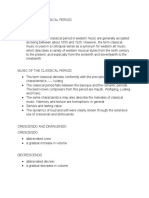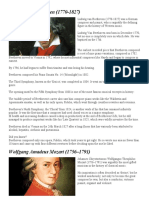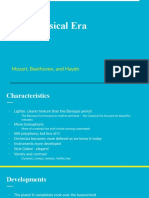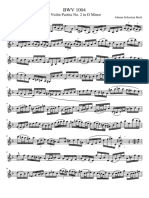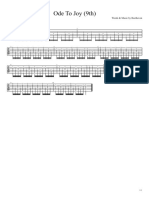0 ratings0% found this document useful (0 votes)
10 viewsARTICLES
ARTICLES
Uploaded by
Elmalyn BernarteFranz Joseph Haydn (1732-1809) was an Austrian composer during the Classical period known as the "Father of the Symphony". He came from humble beginnings but found success working for wealthy patrons like the Esterhazy family. Haydn composed over 100 symphonies and helped develop the genre. He also wrote chamber music and was known for his piano trios. Wolfgang Amadeus Mozart (1756-1791) was one of the most famous and prolific composers of the Classical period. He showed musical talent from a young age and composed in many genres, including symphonies, operas, and chamber works. Ludwig van Beethoven (1770-1827) was a German
Copyright:
© All Rights Reserved
Available Formats
Download as DOCX, PDF, TXT or read online from Scribd
ARTICLES
ARTICLES
Uploaded by
Elmalyn Bernarte0 ratings0% found this document useful (0 votes)
10 views3 pagesFranz Joseph Haydn (1732-1809) was an Austrian composer during the Classical period known as the "Father of the Symphony". He came from humble beginnings but found success working for wealthy patrons like the Esterhazy family. Haydn composed over 100 symphonies and helped develop the genre. He also wrote chamber music and was known for his piano trios. Wolfgang Amadeus Mozart (1756-1791) was one of the most famous and prolific composers of the Classical period. He showed musical talent from a young age and composed in many genres, including symphonies, operas, and chamber works. Ludwig van Beethoven (1770-1827) was a German
Copyright
© © All Rights Reserved
Available Formats
DOCX, PDF, TXT or read online from Scribd
Share this document
Did you find this document useful?
Is this content inappropriate?
Franz Joseph Haydn (1732-1809) was an Austrian composer during the Classical period known as the "Father of the Symphony". He came from humble beginnings but found success working for wealthy patrons like the Esterhazy family. Haydn composed over 100 symphonies and helped develop the genre. He also wrote chamber music and was known for his piano trios. Wolfgang Amadeus Mozart (1756-1791) was one of the most famous and prolific composers of the Classical period. He showed musical talent from a young age and composed in many genres, including symphonies, operas, and chamber works. Ludwig van Beethoven (1770-1827) was a German
Copyright:
© All Rights Reserved
Available Formats
Download as DOCX, PDF, TXT or read online from Scribd
Download as docx, pdf, or txt
0 ratings0% found this document useful (0 votes)
10 views3 pagesARTICLES
ARTICLES
Uploaded by
Elmalyn BernarteFranz Joseph Haydn (1732-1809) was an Austrian composer during the Classical period known as the "Father of the Symphony". He came from humble beginnings but found success working for wealthy patrons like the Esterhazy family. Haydn composed over 100 symphonies and helped develop the genre. He also wrote chamber music and was known for his piano trios. Wolfgang Amadeus Mozart (1756-1791) was one of the most famous and prolific composers of the Classical period. He showed musical talent from a young age and composed in many genres, including symphonies, operas, and chamber works. Ludwig van Beethoven (1770-1827) was a German
Copyright:
© All Rights Reserved
Available Formats
Download as DOCX, PDF, TXT or read online from Scribd
Download as docx, pdf, or txt
You are on page 1of 3
FRANZ JOSEPH HAYDN (1732-1809)
Franz Joseph Haydn (1732–1809) was an Austrian composer,
one of the most prolific and prominent composers of the Classical
period. His life is described as a “rags-to-riches” story. He came
from a poor family and his music led to his rise in social status. He
was hired by rich patrons and eventually became a musical director
for the Esterhazy family for 30 years.
Franz Joseph Haydn was called the father of the symphony
because he contributed so much to this genre of music. Haydn
composed over 100 symphonies. Haydn also composed and made
famous chamber music, which evolved into symphonic music.
Haydn was noted for his piano trios, with piano, cello and violin.
His music reflects his character and personality: mainly calm,
balanced, serious but with touches of humor. He was able to
compose over 100 symphonies and developed them into long forms
for a large orchestra. He was named, “Father of the Symphony”
although he excelled in every music genre of the period. Most of his
symphonies have nicknames such as the “Surprise Symphony”,
“The Clock”, “The Military”. He also wrote chamber piano music and
choral works.
WOLFGANG AMADEUS MOZART (1756-1791)
Wolfgang Amadeus Mozart (1756-1791) was one of the most
influential, popular and prolific composers of the classical period.
He composed over 600 works, including some of the most famous
and loved pieces of symphonic, chamber, operatic, and choral
music. Mozart was born in Salzburg to a musical family. From an
early age, the young Mozart showed all the signs of a prodigious
musical talent. By the age of 5 he could read and write music, and
he would entertain people with his talents on the keyboard. By the
age of 6 he was writing his first compositions. Mozart was generally
considered to be a rare musical genius, though Mozart said that he
was diligent in studying other great composers such as Haydn and
Bach.
He experimented in all kinds of music and composed over 700
works. Unfortunately, due to mismanaged finances he lived his life
in poverty, died young and was buried in an unknown grave. He
composed wonderful concertos, symphonies and opera such as “The
Marriage of Figaro” (1786), “Don Giovanni (1789), and “The Magic
Flute” which became popular. Other known works: Eine Kleine
Nachtmusik, Symphony No. 40 in G Major, and Sonata No.11 in A
Major K311. The central traits of the classical style are all present
in Mozart's music. Clarity, balance, and transparency are the
hallmarks of his work, but simplistic notions of its delicacy mask
the exceptional power of his finest masterpieces, such as the Piano
Concerto No. 24 in C minor, K.
LUDWIG VAN BEETHOVEN (1770-1827)
Ludwig van Beethoven (1770-1827) was a German composer
and pianist, who is arguably the defining figure in the history of
Western music. Ludwig Van Beethoven was born in December
1770, but no-one is completely sure on which date. He was baptized
on the 17th.
He was the composer who bridged the late Classical era and
the early Romantic era. He was a talented pianist and composer.
His famous compositions include 32 piano sonatas, 21 set of
variations, 9 symphonies, 5 concertos for piano, 16 string quartets
and choral music.
His works include the “Missa Solemnis” (1818-1823) and
opera “Fidelio” (1805). His known symphonies are Symphony No. 3
(Eroica), No. 5, No. 6 (Pastoral), No. 9 (Choral), which adds voices to
the orchestra. He began to go deaf in 1796 but this did not become
a hindrance. He continued composing through the help of an
assistant and hearing gadget. Some of his famous compositions
were made when he was deaf. His music veered toward larger
orchestras. - Sound was centered on the violas and lower registers
of the violins and cellos to give his music a darker mood. - All
themes in a piece are tied together by one motif. - He developed
musical themes and motifs extensively by means of modulation - He
used more brass instruments and dynamics.
You might also like
- Music of The Classical PeriodDocument19 pagesMusic of The Classical PeriodEina Reyes Rocillo100% (5)
- Notable Composers in Western Music: SparkChartsDocument6 pagesNotable Composers in Western Music: SparkChartsElizabeth Alarcón-GaxiolaNo ratings yet
- Erik Satie Gymnopedie 1 Sheet Music PDFDocument1 pageErik Satie Gymnopedie 1 Sheet Music PDFMaria0% (2)
- Telemann - Sonata in C TWV 41 C2 For Recorder and GuitarDocument10 pagesTelemann - Sonata in C TWV 41 C2 For Recorder and GuitarNalin KomentrakarnNo ratings yet
- MAPEH 9 - MusicDocument2 pagesMAPEH 9 - MusicFelcaflor Taño ClaritoNo ratings yet
- q2 Music Lesson 2Document15 pagesq2 Music Lesson 2Mark MosquitoNo ratings yet
- Music of The Classical Period 2nd QDocument10 pagesMusic of The Classical Period 2nd QJonifer Orendez AlmeidaNo ratings yet
- q2.Life and Works of the Classical ComposersDocument11 pagesq2.Life and Works of the Classical ComposersJeth Irah CostanNo ratings yet
- Jean Rien C. Armenion ABComm. 111-ADocument7 pagesJean Rien C. Armenion ABComm. 111-AnerakyojNo ratings yet
- Music ReviewDocument2 pagesMusic ReviewGesta QuennieNo ratings yet
- Classical MusicDocument34 pagesClassical MusicMillette Mesa ArañasNo ratings yet
- Music of The Classical PeriodDocument5 pagesMusic of The Classical PeriodelNo ratings yet
- MAPEHDocument3 pagesMAPEHchinie rose floresNo ratings yet
- TankaDocument34 pagesTankaKyle Adrian Prado MostarNo ratings yet
- Script Joseph HaydnDocument3 pagesScript Joseph HaydnSoria Sophia AnnNo ratings yet
- Wolfgang Amadeus Mozart: Anna Maria Leopold MozartDocument6 pagesWolfgang Amadeus Mozart: Anna Maria Leopold MozartJanelle LumactodNo ratings yet
- Classical PeriodDocument15 pagesClassical PeriodAlecza Jewen GonzalesNo ratings yet
- music 9Document2 pagesmusic 9April JadeNo ratings yet
- Composers of The Classical PeriodDocument9 pagesComposers of The Classical PeriodFitzgerald BabieraNo ratings yet
- Week of August 24 Grade 7 Study MaterialDocument2 pagesWeek of August 24 Grade 7 Study MaterialyalindogrusozNo ratings yet
- Music of The Classical PeriodDocument4 pagesMusic of The Classical Periodmcheche12No ratings yet
- Wolfgang Amadeus Mozart Was One of The Most Significant and Influential of AllDocument1 pageWolfgang Amadeus Mozart Was One of The Most Significant and Influential of AlljasMine jAsMiNeNo ratings yet
- Wolfgang Amadeus MozartDocument2 pagesWolfgang Amadeus MozartMarlon DungcaNo ratings yet
- 10 Classical Music ComposersDocument4 pages10 Classical Music ComposersRochelle Faye AclagNo ratings yet
- The Classical Period FinalDocument14 pagesThe Classical Period FinalEdward O' GormanNo ratings yet
- The Classical Era Lecture 3Document4 pagesThe Classical Era Lecture 3Butid SoktoevaNo ratings yet
- Performance Task in MapehDocument11 pagesPerformance Task in MapehAva BarramedaNo ratings yet
- The Classical EraDocument3 pagesThe Classical EraMaria Zaira L. RiveraNo ratings yet
- Classical Period (1750 - 1820)Document7 pagesClassical Period (1750 - 1820)Sir RavenNo ratings yet
- Music 9 of The Classical PeriodDocument2 pagesMusic 9 of The Classical Periodlouisepearl.borinagaNo ratings yet
- G 10 AA ReportDocument23 pagesG 10 AA ReportSarah J LeonorNo ratings yet
- Ludwig Van BeethovenDocument12 pagesLudwig Van Beethovenanghie28No ratings yet
- 2ND Quarter Handout in Mapeh TrueDocument27 pages2ND Quarter Handout in Mapeh Truecarlevannava62No ratings yet
- Q2 W2 Classical Period Musical ComposersDocument15 pagesQ2 W2 Classical Period Musical ComposersAina Charisse DizonNo ratings yet
- Franz Joseph HaydnDocument7 pagesFranz Joseph HaydnMckevinSeguraNo ratings yet
- Topic 7Document6 pagesTopic 7gheralfredNo ratings yet
- Submitted By: Submitted To: Aries D. Marzo Mrs. Editha PagcaliwanganDocument11 pagesSubmitted By: Submitted To: Aries D. Marzo Mrs. Editha PagcaliwanganShin MarshNo ratings yet
- Classical Music ComposersDocument3 pagesClassical Music ComposersAnabelle Pandac PerezNo ratings yet
- MAPEHDocument10 pagesMAPEHJohn Mark AguijonNo ratings yet
- MusicDocument5 pagesMusicJustine PaningbatanNo ratings yet
- Book of ComposerjpDocument4 pagesBook of Composerjpbryanatencio82No ratings yet
- 2q Music of the Classical PeriodDocument3 pages2q Music of the Classical Periodgia85223No ratings yet
- Baroque MusicDocument24 pagesBaroque Musicpao manaligodNo ratings yet
- The Classical EraDocument14 pagesThe Classical Eravenus_marivicNo ratings yet
- Beethoven Haydn MozartDocument31 pagesBeethoven Haydn MozartSarahNo ratings yet
- Franz Peter Schubert: Claire Gui Band VDocument16 pagesFranz Peter Schubert: Claire Gui Band VMarko AskovicNo ratings yet
- Classical Period ComposersDocument1 pageClassical Period Composerschessy De solaNo ratings yet
- Musicians CPEG6 CompressedDocument16 pagesMusicians CPEG6 CompressedJhonavil ReyesNo ratings yet
- The History of MusicDocument26 pagesThe History of MusicjosuegomezNo ratings yet
- Classical PeriodDocument15 pagesClassical PeriodKate Clancy Nugao100% (1)
- Top 20 Music Composers of All Time: 1. Johann Sebastian BachDocument4 pagesTop 20 Music Composers of All Time: 1. Johann Sebastian BachjoanaNo ratings yet
- Music of The Classical PeriodDocument3 pagesMusic of The Classical Periodbilly sauraNo ratings yet
- ComposersDocument5 pagesComposersMa Sharafova CastañedaNo ratings yet
- Music of Romantic PeriodDocument38 pagesMusic of Romantic PeriodElmer John De Leon100% (1)
- History of Classical Period 1730-1820Document9 pagesHistory of Classical Period 1730-1820Mary Rose QuimanjanNo ratings yet
- The Great Composer of The Romantic PeriodDocument3 pagesThe Great Composer of The Romantic PeriodMenor LorenceNo ratings yet
- ParthaPratimBhowmik BA2-2 1-Ben 01062020Document7 pagesParthaPratimBhowmik BA2-2 1-Ben 01062020purearpanNo ratings yet
- Music NotesDocument4 pagesMusic NotesAeron YbanezNo ratings yet
- Music Appreciation - The Classical EraDocument87 pagesMusic Appreciation - The Classical EraLogan BinghamNo ratings yet
- MusicDocument25 pagesMusicrubiosherylmaeNo ratings yet
- Midieval Period Hildegard Von BingenDocument10 pagesMidieval Period Hildegard Von BingenLhen NonanNo ratings yet
- WEEKLY TEST SCIENCE 3rdDocument4 pagesWEEKLY TEST SCIENCE 3rdElmalyn BernarteNo ratings yet
- Maria MakilingDocument10 pagesMaria MakilingElmalyn BernarteNo ratings yet
- Activity - PeaceDocument12 pagesActivity - PeaceElmalyn BernarteNo ratings yet
- PEACEDocument5 pagesPEACEElmalyn BernarteNo ratings yet
- List of Group Screening Test in Filipino.4Document2 pagesList of Group Screening Test in Filipino.4Elmalyn BernarteNo ratings yet
- Weekly Tests Science Q2Document4 pagesWeekly Tests Science Q2Elmalyn BernarteNo ratings yet
- Science 4 Quarter 2 Week 7Document7 pagesScience 4 Quarter 2 Week 7Elmalyn BernarteNo ratings yet
- Worksheet in Science 4 Third QuarterDocument8 pagesWorksheet in Science 4 Third QuarterElmalyn Bernarte100% (2)
- Schubert - SERENADE - Quartet - Parts ScoreDocument8 pagesSchubert - SERENADE - Quartet - Parts ScoreAlfonso Rada Vargas100% (1)
- Tchaikovsky - Variations On A Rococo Theme For Cello and Orchestra, Op 33 (Orchestral Score)Document42 pagesTchaikovsky - Variations On A Rococo Theme For Cello and Orchestra, Op 33 (Orchestral Score)crepuscular1974100% (1)
- Have Yourself A Merry Little Christmas PDFDocument2 pagesHave Yourself A Merry Little Christmas PDFEvan MeauxNo ratings yet
- Music Reviewer For Grade 09Document2 pagesMusic Reviewer For Grade 09clairealejandrino.ncapNo ratings yet
- Symphony No. 5 in C Minor Op. 67, 1. Allegro Con Brio (Original Key)Document3 pagesSymphony No. 5 in C Minor Op. 67, 1. Allegro Con Brio (Original Key)nando_metal3dNo ratings yet
- Famous Opera ChorusesDocument2 pagesFamous Opera ChorusesJuan CasasbellasNo ratings yet
- Dvorak - Stabat Mater - Vocal Score & PianoDocument93 pagesDvorak - Stabat Mater - Vocal Score & PianoHadi Manavi100% (6)
- Hungarian Rhapsody No.2 S.2442 Franz Liszt 60 Similar To Tom and Jerry ArrangementDocument14 pagesHungarian Rhapsody No.2 S.2442 Franz Liszt 60 Similar To Tom and Jerry ArrangementGabrielaatsNo ratings yet
- Houston Grand Opera Orchestra Houston Ballet OrchestraDocument18 pagesHouston Grand Opera Orchestra Houston Ballet OrchestraDavid AllenNo ratings yet
- The Singing Voice of Your Dreams Is Inside You : Written by Geoffrey WilliamsDocument47 pagesThe Singing Voice of Your Dreams Is Inside You : Written by Geoffrey WilliamsAlbina LirNo ratings yet
- Georg Ots - CD NotesDocument1 pageGeorg Ots - CD NotesRadu RadescuNo ratings yet
- Bach Gammon - Piano SoloDocument5 pagesBach Gammon - Piano SoloHellenTafurNo ratings yet
- Lobt Gott, Ihr Christen Allzugleich: Choralbearbeitung, BWV 732Document1 pageLobt Gott, Ihr Christen Allzugleich: Choralbearbeitung, BWV 732Thomas MüllerNo ratings yet
- Dancing QueenDocument12 pagesDancing Queennicole100% (1)
- Impromptu Op. 90 D. 899 No. 2 in E-Flat Major - Franz SchubertDocument11 pagesImpromptu Op. 90 D. 899 No. 2 in E-Flat Major - Franz SchubertBálint DerényiNo ratings yet
- Ave Maria Gounod_F Violin IIDocument1 pageAve Maria Gounod_F Violin IItecnicos hhyaaNo ratings yet
- Crusell - Concerto For Clarinet No 1 Op 1 - Full ScoreDocument113 pagesCrusell - Concerto For Clarinet No 1 Op 1 - Full ScorezypbuffetNo ratings yet
- Drumline Commitment ScheduleDocument2 pagesDrumline Commitment ScheduleTayaNo ratings yet
- Dance of the KnightsDocument2 pagesDance of the KnightsDan RedmondNo ratings yet
- Before You Go Music SheetDocument7 pagesBefore You Go Music SheetIke Kashaka Tshikung0% (1)
- Piano Solo Repertoire 2019Document8 pagesPiano Solo Repertoire 2019api-3151452120% (1)
- Italian Vs French Baroque Operas.Document5 pagesItalian Vs French Baroque Operas.tanNo ratings yet
- 1756 Mozart 1775 Violin Concerto 05 TurkishDocument32 pages1756 Mozart 1775 Violin Concerto 05 TurkishMark AlburgerNo ratings yet
- JESUS, ALEGRIA DOS HOMENS Baritone SaxophoneDocument1 pageJESUS, ALEGRIA DOS HOMENS Baritone SaxophoneLarissa MacedoNo ratings yet
- Sonata No. 16 in C MajorDocument14 pagesSonata No. 16 in C MajorGabriel SilvaNo ratings yet
- Violin Partita No. 2 in D Minor: AllemandaDocument16 pagesViolin Partita No. 2 in D Minor: Allemandafaro2000No ratings yet
- PMLP59201-Vivaldi Concerto 2 Oboes RV 535Document7 pagesPMLP59201-Vivaldi Concerto 2 Oboes RV 535dngrxNo ratings yet
- Beethoven - Ode To Joy (9th)Document1 pageBeethoven - Ode To Joy (9th)Mariano Torres SilvaNo ratings yet











